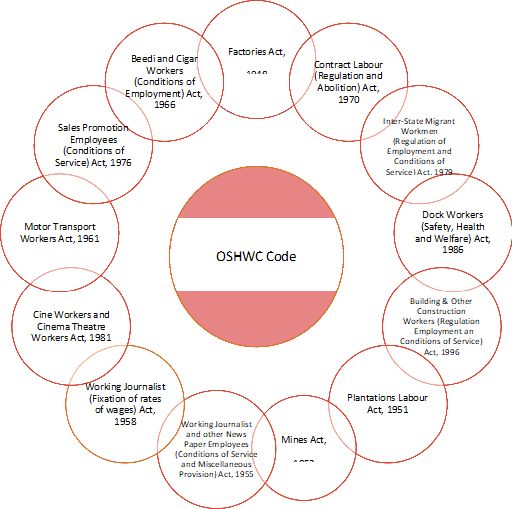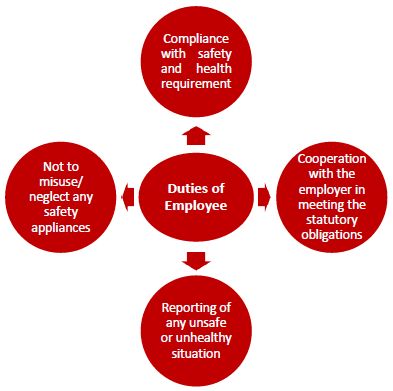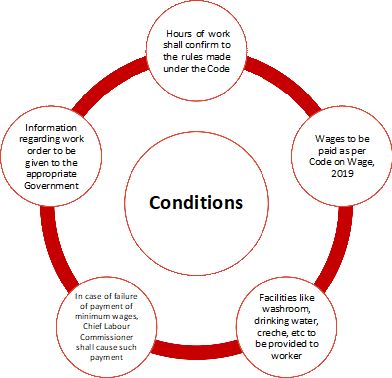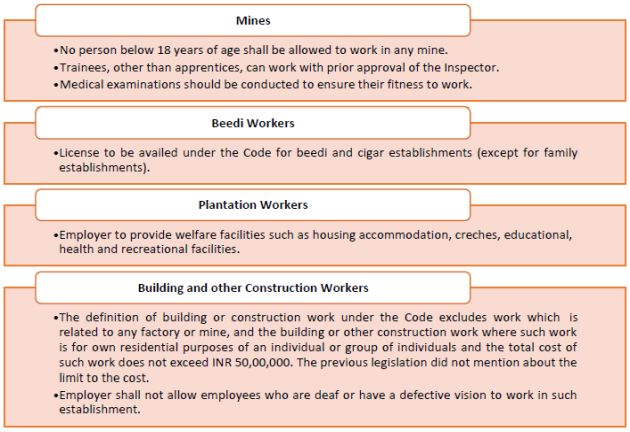- within Finance and Banking topic(s)
- in Africa
I. INTRODUCTION
The Occupational Safety, Health and Working Conditions Code, 2020 ("OSHWC Code" or "Code") is the third code under our 4-part series on the new labour legislations. The OSHWC Code aims to regulate the safety, health, and working conditions of various establishments. This note provides a brief overview of the worker's welfare and working conditions as enumerated under the Code.
The OSHWC Code integrates 13 existing labour legislations within itself to bring uniformity and streamline the labour laws regime. The broad framework of the Code shall bring down 622 sections from the previous laws to 134 sections with an aim to cover all the scenarios relating to the health and safety of the workmen with simplified and easier compliances. The Code ensures that instead of mandating registrations under multiple regulations, there will just be one registration for each license and one annual return submission.

II. APPLICABILITY AND SCOPE
The Code shall apply to all establishments. The definition of 'establishments' under the existing 13 labour legislations was not uniform. To bring about uniformity, the Code has defined 'establishment' as follows:
- A place where any industry, trade, business, manufacturing, or occupation is carried on in which 10 or more workers are employed; or
- a motor transport undertaking, newspaper establishment, audio-video production, building, and other construction work or plantation, in which 10 or more workers are employed; or
- a factory in which 10 or more workers are employed; or
- a mine or port or vicinity of the port where dock work is carried out.
Although the Code does not apply to offices of the Central Government or State Government, it does apply to contract labourers employed through a contractor in the offices where Central Government or State Government are principal employers.
III. LICENSE AND REGISTRATION
To eliminate the multiple registration requirements under various legislations, the Code has introduced provisions for 'one registration' requirement.
New establishments covered under the Code shall be required to register through electronic means within 60 days of the commencement of the Code, with the registering officers appointed by the Central or State Government. Establishments such as factories and mines, and those hiring workers such as beedi and cigar workers, may be required to obtain additional common licenses to operate.
The existing establishments, registered under any other central labour laws, shall be deemed to be registered under the Code and shall not be required to obtain fresh registrations.
As per the Occupational Safety, Health and Working Conditions (Central) Rules, 2020 ("Rules"), the employer will have to update the registration particulars on the 'Shram Suvidha' portal within 6 months from the date on which the Code comes into force.
IV. DUTIES OF EMPLOYER AND EMPLOYEE Duties of Employer
The Code expands the definition of employer to include persons who, directly or through any other person, employ employees, and includes legal representatives of a deceased employer. Earlier, the definition of 'employer' under the Plantation Labour Act, 1951 was limited to such employer having ultimate control over the affairs of the establishment which is now also included under the new definition of employer.
As per the Code, every employer should issue a letter of appointment to the employee on his appointment within 3 months after the Code comes into effect.

The employer is also required to maintain an electronic register in the manner prescribed by the appropriate government to keep note of the work performed by the employees, the number of hours of work constituting normal working hours in a day; the day of rest allowed in every period of 7 days; wage paid and receipts are given therefor; leave, leave wages, overtime work, attendance, and dangerous occurrences; and employment of adolescent. The employer shall also display a notice at the workplace of the workers with the abovementioned details, issue wage slips to the workers (electronic or otherwise) and file a return of all such information with the Inspector-cum-Facilitator.
Duties of Employee
The Code also lays down certain conditions of employment that an employee is required to comply with in an establishment.

V. OCCUPATIONAL SAFETY AND HEALTH ADVISORY BOARDS
The Code establishes occupational safety boards at the national and state level to advise the Central and State Governments on the standards, rules, and regulations to be framed under the Code. The board consists of various experts from the Central Government and the State Government.
VI. INSPECTOR-CUM-FACILITATOR
The appropriate government will appoint Inspector-cum-facilitators ("Inspector") who will be empowered to enter workplaces, inspect establishments and their machinery, inquire into any accidents or dangerous occurrences, require the production of any register or any other document relating to the workplace, search or seize or take copies of any register, take samples of any substances and issue show cause notices relating to safety, health, and welfare violations. The Inspector shall be empowered to prosecute, conduct, and defend before any court any complaint or other proceeding arising under the Code and the Rules thereunder.
VII. WORK HOURS AND LEAVES

VIII. SPECIAL PROVISIONS RELATING TO WOMEN EMPLOYEES
The women workers shall be entitled to do all kinds of work in all establishments and work night shifts from 7 PM to 6 AM with their consent, subject to conditions prescribed by the Government relating to safety, holidays, and working hours. Previously, women were prohibited from working at night under the Factories Act, 1948. The employer must arrange adequate safeguards for the women employees in operations which are considered dangerous for health and safety.
IX. SPECIAL PROVISIONS ON CONTRACT LABOUR AND INTER-STATE MIGRANT WORKERS
The scope of the new definition of 'contract labour' excludes workers (besides part-time employees) who are regularly employed by the contractor for any economic activity whereby such worker's employment is governed by mutually accepted employment standards and gets periodical increment in pay and other welfare incentives.
The provisions of the Code that pertain to contract labour would only apply to establishments that hire 50 or more contract labourers. The Code provides that a contractor can employ contract labourers through a common license, an application for which shall be made online through the 'Shram Suvidha Portal' of the Ministry of Labour and Employment. The contractor license shall be granted based on the fulfilment of certain conditions by the contractor.

If the conditions are not met, then the Central Government may issue only a 'work specific license', for the concerned work order as may be specified in such license.
The Code provides certain benefits for inter-state migrant workers. These include (i) the option to avail the benefits of the public distribution system either in the native state or the state of employment, (ii) the availability of benefits available under the building and other construction cess fund in the state of employment, (iii) insurance and provident fund benefits available to other workers in the same establishment, and (iv) toll-free helpline number.
X. SPECIAL PROVISIONS FOR FACTORIES
The appropriate government may declare any place carrying on a manufacturing process as a 'factory', irrespective of the minimum number of workers in a factory. The threshold under the new definition has been increased to 20 workers from 10 workers for premises where the work process uses power and 40 workers from 20 where the work process does not use power. The appropriate government may require provisions of added facilities like ambulance rooms, welfare officers, and temporary housing.
For the factories involved in hazardous processes, the maximum permissible limits of exposure to chemical and toxic substances in manufacturing processes will be prescribed by the State Government. Further, it may specify medical examinations for workers, among other facilities. Emergency standards may be set for enforcement of suitable standards in respect of such hazardous processes. If it appears that workers are in danger, the Inspector may limit the number of employees working or prohibit work in an establishment.
XI. SPECIAL PROVISIONS FOR AUDIO-VISUAL WORKERS
The concept of audio-visual production has been newly introduced in the Code. The definition includes: (i) animation, cartoon depiction, audio-visual advertisement; (ii) digital production, and; (iii) features films, non-feature films, television, web-based serials, talk shows, reality shows, and sports shows. Audio-visual workers include actors, musicians, singers, dancers, news readers, anchors, dubbing artists and stunt persons.
XII. SPECIAL PROVISIONS FOR OTHER TYPES OF WORKERS
The definition of 'worker' has been introduced in the Code. While it is quite similar to the definition of an 'employee' under the OSHWC Code, it specifically excludes (i) persons employed in a supervisory capacity whose monthly salary is INR 18,000 or more; or (ii) persons who are employed mainly in a managerial and administrative capacity. Below are some provisions on other types of workers governed under the Code.

XIII. AMENDMENTS TO THE THRESHOLDS
The thresholds have been amended under the Code, changing the applicability of certain provisions.
| Provision | No. of employees required for applicability of provision | |
| Previous | New | |
| Factory-related provisions in case of factories utilising power | 10 | 20 |
| Factory related provisions in case of factories not utilising power | 20 | 40 |
| Contract labour provisions | 20 | 50 |
| Provision for creche facility | 30 | 50 |
| Provision for canteen | 250 | 100 |
| Appointment of welfare officer (factory, mine, or plantation) | 500 | 250 |
XIV. PENALTIES
If there is any contravention of the provisions of the Code or Rules, or bye-laws or any of standards, made thereunder by the establishment, the employer or the principal employer of the establishment, shall be liable to a penalty which shall not be less than INR 2,00,000 but which may extend up to INR 3,00,000, and if the contravention continues after the conviction, then, with a further penalty which may extend to INR 2,000 for each day till such contravention continues.
The content of this article is intended to provide a general guide to the subject matter. Specialist advice should be sought about your specific circumstances.



